Racial Integration in K-12 Schools
Document Presets
To download, choose the "Save as PDF" option when asked to choose a printer.
Primary Source Set
Racial Integration in K-12 Schools
In the mid-20th century, the Supreme Court ruled that schools were no longer able to segregate students by race. This collection uses high school yearbooks, newspaper articles, photographs, video and oral history to illustrate how education changed between the 1954 Brown v. Board of Education ruling and the mid-1970s, when North Carolina finally met the requirements set by that case.
Time Period
1950s to 1970s
Grade Level
7 – 12
Selected Sources
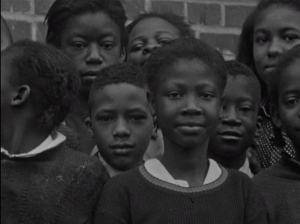
Wadesboro, N.C., 1938 movie
Wadesboro, N.C. (Anson County), 1938
These photos are from a short, silent movie created by H. Lee Waters in 1938. It is part of Waters’ project, “Movies of Local People,” where he filmed scenes of life around Wadesboro, N.C. The beginning of the video takes place in town, where people are walking around and smiling at the camera. Then, beginning at 1:22, Waters films the students and staff of two schools, one for Black students and one for white students. In 1938, North Carolina could legally segregate schools by race. This video offers a look at what schools looked like before integration began.
Contributed to DigitalNC by State Archives of North Carolina
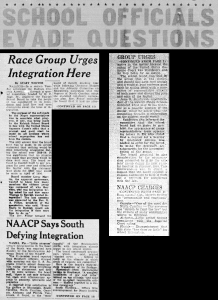
Two articles from The Carolinian, published in Raleigh, N.C. (1955)
Raleigh, N.C. (Wake County), 1955
The Carolinian is a Black-owned and run newspaper based in Raleigh. In 1955, it was owned by Paul Reginald Jervay Sr., an experienced publisher with family ties to journalism. Black newspapers like The Carolinian often covered issues and perspectives omitted from white-owned publications. In the 1930s, this paper had a “Schools & Colleges” section, which featured Black schools from around the state.
Contributed to DigitalNC by Olivia Raney Local History Library
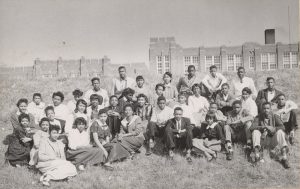
Students at Dudley High School, c. 1957
Greensboro, NC (Guilford County), 1957
Dudley High School was a Black high school in Greensboro, N.C. It is estimated that this photo is from around 1957. This is an example of a racially homogenous class of Black students, though this photo was likely taken after the Brown v. Board ruling.
It was also around this time that four students from North Carolina A&T University (a historically Black university) also began the famous Greensboro sit-in protests at Woolworth’s lunch counter (1960). The first four demonstrators—Jibreel Khazan, Franklin E. McCain, Joseph A. McNeil, and David L. Richmond—were first year students, close to the same age as these students.
Contributed to DigitalNC by Dudley Alumni Association
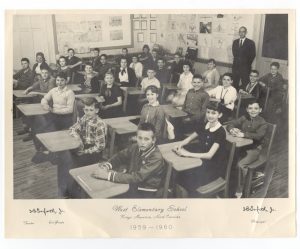
Sixth Grade Class of West Elementary School, Kings Mountain, N.C., c. 1960
Kings Mountain, NC (Cleveland County, Gaston County), 1960
This photo from the Kings Mountain Historical Museum depicts a class of sixth graders at West Elementary School in Kings Mountain, N.C., during the 1959-1960 school year. The principal and sixth grade teacher in the photo is J.B. Goforth, Jr. This is an example of a racially homogeneous classroom where all of the students are white.
Contributed to DigitalNC by Kings Mountain Historical Museum
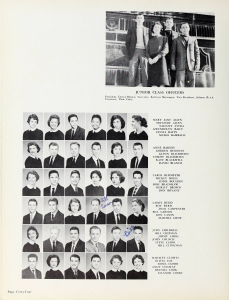
Gwendolyn Bailey in the Black and Gold [1958] yearbook, R.J. Reynolds High School
Winston-Salem, N.C. (Forsyth County), 1958
One early integration strategy was to move a few Black students—or sometimes just one student—to an all-white school. In 1958, Gwendolyn Bailey (top row, fourth from left) was the first and only Black student to attend R. J. Reynolds High School. She was escorted by reporters on her first day.
Contributed to DigitalNC by Forsyth County Public Library
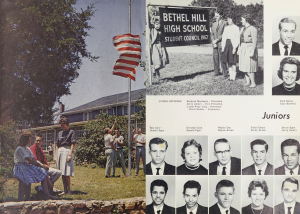
The Hilltopper [1963] yearbook, Bethel Hill High School
Woodsdale, N.C. (Person County), 1963
Like Black and White students, Native American students also went to segregated schools in the early 20th century. One such school was the High Plains Indian School in Person County, N.C., where members of the Sappony and Haliwa-Sapponi tribes could attend school along with Native American students from Virginia. The school was closed in 1962 as part of integration, and students joined the previously white Bethel Hill High School and Allensville High School.
These yearbook pages are from Bethel Hill High School’s The Hilltopper [1963], the year when Native American students formally joined the student body.
Contributed to DigitalNC by Person County Public Library
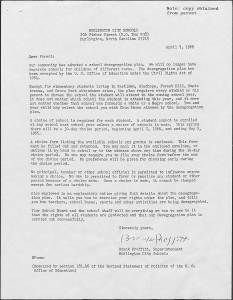
Notice of School Desegregation Plan Under Title VI of the Civil Rights Act of 1964
Burlington, N.C. (Alamance County), 1966
This letter was sent to parents announcing the racial integration of Burlington City Schools in 1966. The notice on top informs parents of the new school choice plan, where families had to submit a list of their preferred schools. Following this letter are documents explaining the school choice plan that address some common questions.
Contributed to DigitalNC by Alamance County Public Libraries
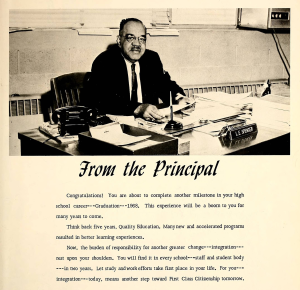
A message from the principal of the Henderson Institute in The Panther [1968] yearbook
Henderson, NC (Vance County), 1968
The Henderson Institute (1887-1970) was one of the first schools in N.C. to educate Black students. In 1968, it was an all-Black high school. This message is from Principal L.E. Spencer, who retired after 22 years in 1969.
Contributed to DigitalNC by Henderson Institute Historical Museum
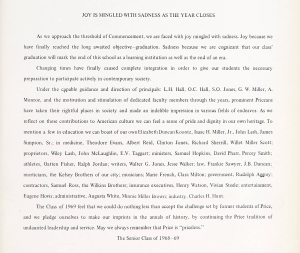
"Joy Is Mingled with Sadness as the Year Closes" in The Pricean [1969], Price High School
Salisbury, N.C. (Rowan County), 1969
This letter from the Price High School class of 1969 reflects on the feelings of students as the school closes due to integration. Price High School was an all-Black high school in Salisbury, N.C.
Contributed to DigitalNC by Rowan Public Library
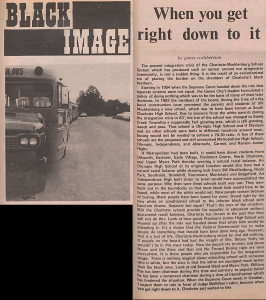
"When you get right down to it," published in The Carolina Journal (1970)
Charlotte, N.C. (Mecklenburg County), 1970
This piece was published in the editorial section of the UNC Charlotte student newspaper, The Carolina Journal. It was published under the banner “Black Image” along with a photograph of a school bus. This piece was published a few months before the Supreme Court ruled in the Swann v. Charlotte-Mecklenburg case that school districts were allowed to use busing as a tool for integrating schools.
Contributed to DigitalNC by University of North Carolina at Charlotte
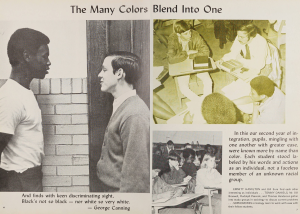
Gohisca [1971], Goldsboro High School
Goldsboro, N.C. (Wayne County), 1971
In the late 1960s and early ’70s, schools in some areas became more racially integrated. At the same time, many private schools opened around the state, creating the opportunity for white families to maintain all-white schools. The differences are clear in the pages of two yearbooks from schools in Goldsboro, N.C.: the Gohisca [1971], from the public Goldsboro High School, and the Charger [1971], from the private Wayne Country Day School (founded in 1968).
Contributed to DigitalNC by Wayne County Public Library
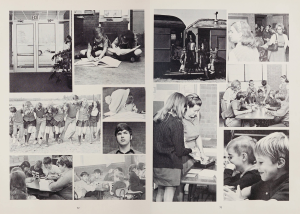
Charger [1971], Wayne Country Day School
Goldsboro, N.C. (Wayne County), 1971
In the late 1960s and early ’70s, schools in some areas became more racially integrated. At the same time, many private schools opened around the state, creating the opportunity for white families to maintain all-white schools. The differences are clear in the pages of two yearbooks from schools in Goldsboro, N.C.: the Gohisca [1971], from the public Goldsboro High School, and the Charger [1971], from the private Wayne Country Day School (founded in 1968).
Contributed to DigitalNC by Wayne County Public Library
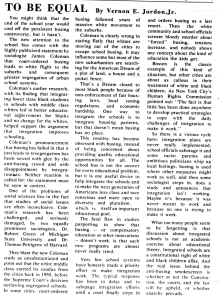
"To Be Equal," published in the Winston-Salem Chronicle
Winston-Salem, N.C. (Forsyth County), 1975
This article, written by Civil Rights lawyer Vernon E. Jordan Jr., was published in several newspapers around the state, including the Black-owned Winston-Salem Chronicle, founded in 1974. Here, Jordan references the Coleman report, a study that investigated the differences in educational opportunities between racial groups in 1966.
Contributed to DigitalNC by Forsyth County Public Library, University of North Carolina at Chapel Hill
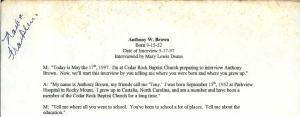
Anthony W. Brown Oral History Interview
Castalia, N.C. (Nash County), 1997
This is an oral history interview with Anthony “Tony” Brown, who describes his experiences as a student attending all-Black schools and his memories of integration. He also describes his mother’s experiences as a teacher in segregated schools.
Suggested times: 3:23-6:30 and 12:35-16:34
Contributed to DigitalNC by Braswell Memorial Library (Rocky Mount, N.C.)
Background
In the early and mid-20th century, students in North Carolina attended schools based on their race. Despite segregationists’ “separate but equal” mantra, schools for white children were often better-resourced, with more money for buildings and school supplies. While schools for Black children usually received less money for textbooks, staff salaries, and facilities, they were still vibrant and close-knit communities. Students identifying as other races, including Native American students, were sometimes educated at Black schools and sometimes able to create schools for themselves, including the High Plains School in Person County. In 1954, the Supreme Court ruled in Brown v. Board of Education of Topeka that schools were no longer able to segregate students by race. However, it took North Carolina 17 years before our state’s schools met the conditions of the Brown v. Board ruling.
Between 1954-1972, lawmakers and community groups debated the best ways to racially integrate schools. Many white families opposed integration and protested by staying home from school or moving to newly-formed private schools. Meanwhile, many Black families worried about leaving the schools they knew, many of which were dissolved as part of integration. One of the largest debates about integration was about busing, a method where students would be bussed across their districts to create schools with racially-balanced student bodies. This method led to the Supreme Court case Swann v. Charlotte-Mecklenburg Board of Education (1971), which confirmed busing as an appropriate strategy and served as the basis for cases around the country.
While the legacy of school integration is complex, this period affected the educational paths of many North Carolinians. One way to more fully understand how students’ lives were changed is to look at examples from yearbooks, photographs, and newspaper articles from this time. In particular, Black community newspapers and yearbooks from Black high schools offer several viewpoints about transitioning to majority-white schools.
Discussion Questions
When did N.C. public schools become racially integrated? Was it in 1954 after Brown v. Board of Education? Was it in 1972, when the state finally met the requirements of the Brown v. Board ruling? Was it sometime in between or after?
Take a look at Gohisca [1971] from Goldsboro High School and Charger [1971] from Wayne Country Day School. What differences do you see? How do the attitudes of students differ? What do these differences tell you about the motivations of private schools during this time period?
Consider the two articles from The Carolinian (Raleigh, N.C.) and the two yearbook excerpts from The Panther [1968] and The Pricean [1969]. What are some of the contrasting feelings coming from community members, school staff, and students? Why do you think each of these authors has these feelings?
In his interview, Tony Brown says that he was glad he stayed at his majority Black school, saying, “We had a lot of very, very caring teachers and it was a smaller environment, nurturing environment.” Given the reactions of some white students and families toward integration, what do you think about Brown’s stance?
School integration in the South sometimes began with one or a few Black students moving to an all-white school (like in the case of Gwendolyn Bailey). Take a moment to imagine yourself in their position. Would you go through with it? Why or why not?
Take a look at The Hilltopper [1963]. This is a yearbook from the first year that Native American students had to attend Bethel Hill High School (previously an all-white school). What surprises you about this yearbook? What do you think this school year was like for students?
If you were a N.C. lawmaker in 1954, what plans would you propose to integrate schools? Would you move all students into the white schools for their resources? Would you use buses to transport students and make the schools racially representative? Would you allow families to choose which schools they wanted to attend?
These materials were compiled by Sophie Hollis. Updated October 2023.
https://www.digitalnc.org/primary-source-sets/racial-integration-k12/
This document was prepared for print on May 10, 2024.